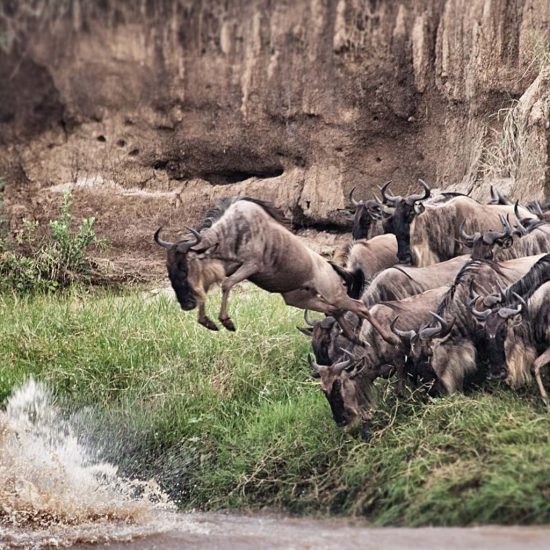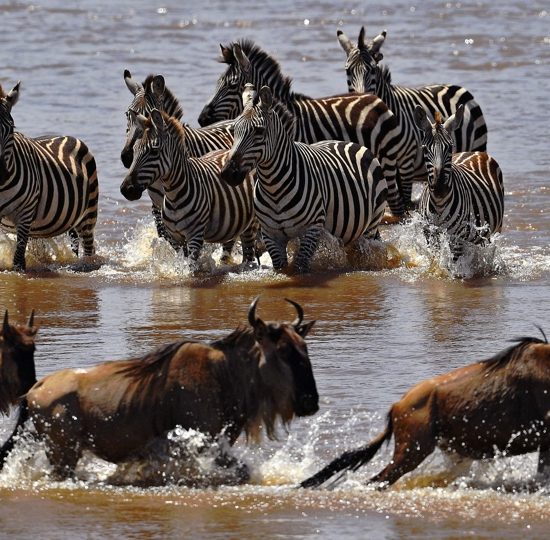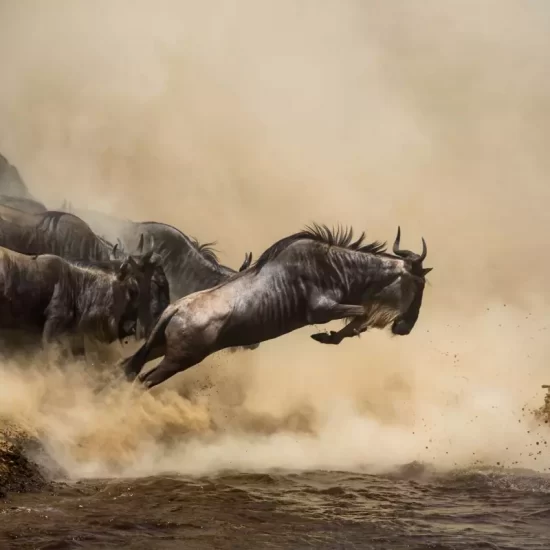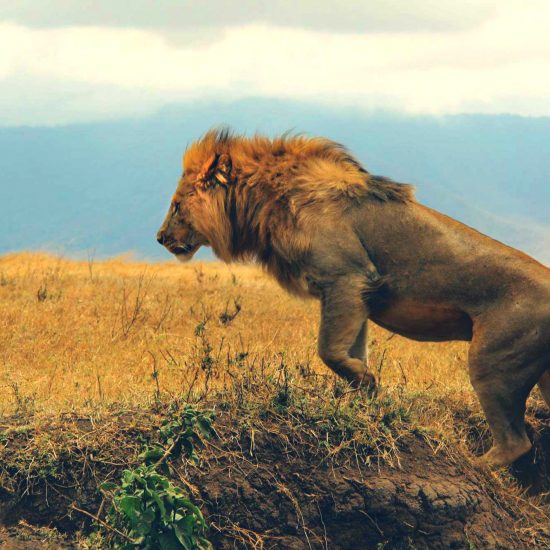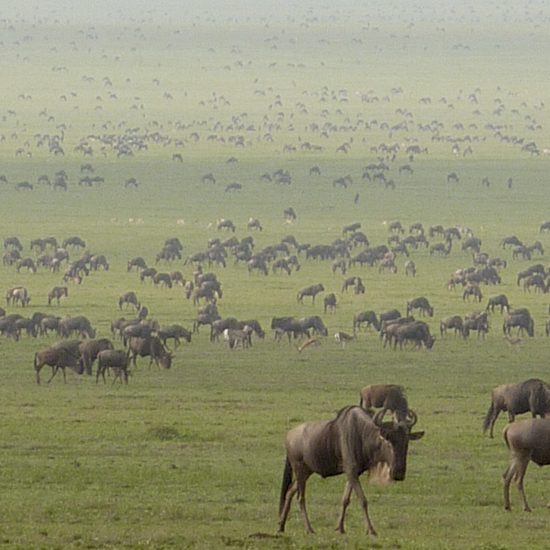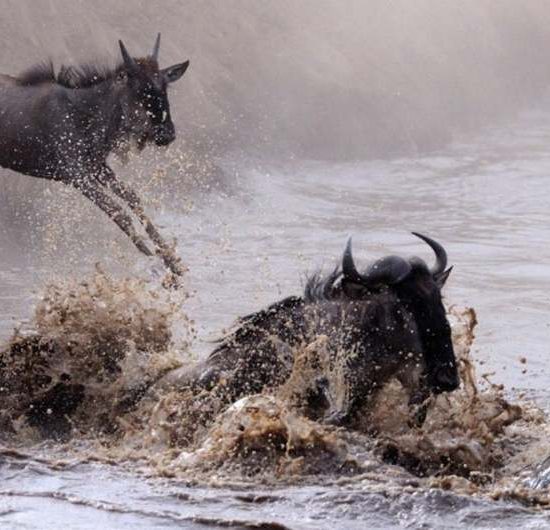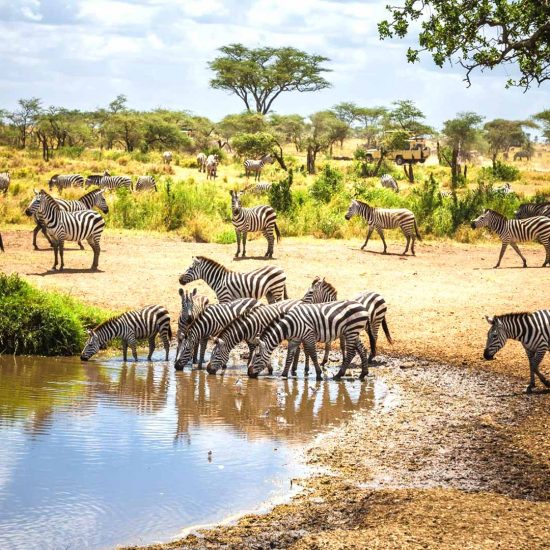The Great Wildebeest Migration
The Great Wildebeest Migration
The Great Migration is East Africa’s most bucket-list-worthy safari experience. Each year, 1.4 million wildebeest, a round trip between Tanzania and Kenya, accompanied by hundreds of thousands of zebra, and gazelle.
The mind-boggling numbers attract wildlife lovers from around the globe to watch the suspenseful river crossings or the 500,000 newly born wildebeest calves take their first steps.
But did you know the Great Migration isn’t a one-and-done event? It’s a year-round cycle, with each month offering a different experience. In this guide, you’ll find a complete breakdown on when is the best time to see the Great Migration and which of the Serengeti’s four regions has the best front-row seat to all the action.
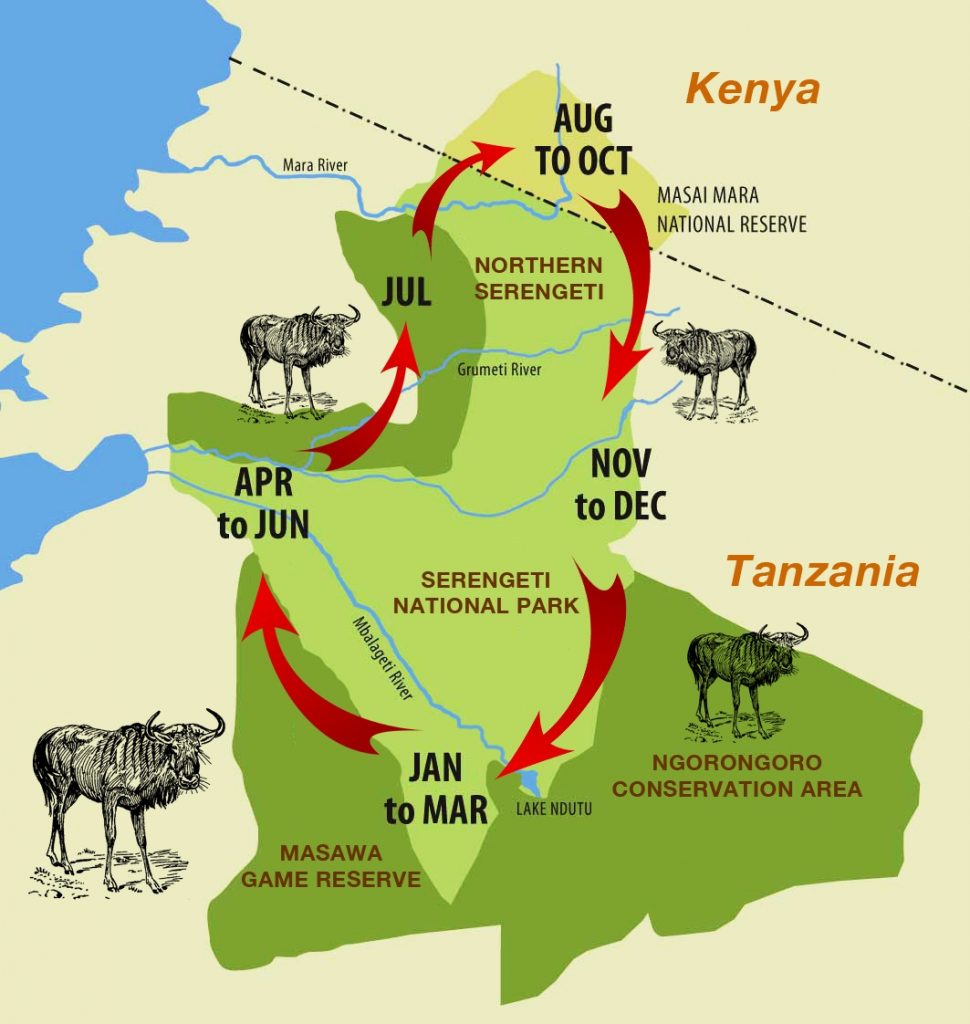
wildebeest calendar programmes
Southern Serengeti wildebeest Migration
The Southern Serengeti wildebeest Migration starts late December with its climax at January before the wildebeests start coming back in March to the central part of Serengeti. The Southern wildebeest migration also known as the calving season Migration happens on the southern part of Serengeti and the Northern part of Ngorongoro conservation area in Ndutu region.
The wildebeest will cover the areas of Kusini of Serengeti park and Ndutu of Ngorongoro conservation Area along the Maswa Game reserve. Kusini Kopjes are a home for the Cheetahs, leopards and the lions who hide and ambush the grazing wildebeest. The ambushed wildebeests are especially those which move a small distance from the team because they make it easy for the predator to attack..
The wildebeest together with Zebras, kobs and other grazers gather on the Ndutu plains to build up their strength after giving birth to the young ones. It is on record that over one thousand young ones are born on daily basis and this attracts more predators as food is plenty through taking the advantage of the newly weak born animals.
On this open grass land in Ndutu which is rich of food values and fresh for the young ones to eat, the wildebeest takes the one month of February from this area before March when they start their journey migrating back to Serengeti National Park through Kusini where the survival for the fittest still takes place with various ambushes of the predators along the way in the Acacia woodlands and Kopjes all acting as hiding places for the predators
When the wildebeest move on, the area is still rich with wildlife, especially fauna depending on the protective microclimates of kopjes, where water collects in basin-like rocks and predators, including lions and jackals, keep vigil from above to see what prey will come to drink. Bizarre aardvark and pangolin feed from towering termite mounds. African hedgehogs, hares and voles dart around the rocks, whilst gaudy lizards scurry over them.
Southern Serengeti especially around the Maswa Game Reserve provides dry season pasture for the animals. This makes more animals head to that area even if it’s not for calving like Buffalos Impalas, Gazelles among others.
Western Serengeti Wildebeest Migration
This Western wildebeest migration occurs during the rainy season in Serengeti national park. That is around April to early June. Large herds of different grazers led by the Wildebeest and followed by other grazing partners like Elands, Zebras, Gazelles and others mill around the Western Corridors of Serengeti south of Grumeti River.
This is one of the deadliest migration in Serengeti due to high concentration of predators both on water (in Grumeti River with giant crocodiles) and on land where grazzers need to escape from the hands of these predators, but hundreds lose their lives at this migration compared to any other migration in Serengeti.
The Western Serengeti safaris takes you beneath an infinite sky of the endless plains of Serengeti as you watch this drama happening live. There are some permanent residents of the wildebeest population who do not migrate but always live around the seasonal Mbalageti River. The mbalageti river runs dry during dry season but before, that the river supports more animals in the area.
Mare beautiful and rare wildlife around the Grumeti River like the Black and white colobus monkey, patas monkey, olive baboon, impala, topi, waterbuck, wildebeest, antelopes and others. During the night game-spotting drives in the private wilderness, look for elusive leopards or nocturnal porcupines, aardvarks, honey badgers and bat-eared foxes.
Northern Serengeti wildebeest migration
The Northern Serengeti Wildebeest migration is the most famous migration and is counted as one of the seven wonders of animals on earth. This wildebeest migration takes place on the extreme North of Serengeti National park around the Lamai Triangle and it’s the largest and mass wildebeest migration. The migration happens from July to September as the wildebeest cross the Mara river to the Maasai Mara national Reserve of Kenya passing through the Serengeti Maasai Mara ecosystem.
The Northern wildebeest migration is more dramatic seeing wildebeest and other grazers throw themselves in water amidst the lager Nile crocodiles in the water. This wildebeest migration is much interesting that humans cannot tell exact date of the migration but fellow animals especially the predators can camp there in time just waiting for the great opportunity to start.
Every wildebeest has a dream to cross and survive yet the crocodiles also count on the animals for their dinner and lunches hence making everything strange as they have to go for the survival for the fittest. The high cliffs of the rift valley escarpments make the river deep and not easy to have a U-turn. Once you’ve entered the river, there no looking back. Other animals to see during the northern wildebeest migration are the elusive Leopards, hippos, Hyrax, Mongoose and others.
In October the wildebeest now start to return back to the Serengeti area hence making the Mara Serengeti ecosystem busy. One can follow the full wildebeest migration by visiting Serengeti in July and then return back to Maasai Mara in October and this will give one full episode of the migration.
Where do the wildebeest migrate to and from?
Wildebeest migration of Tanzania is a worldwide event that is recognised by every traveller wishes to see when he or she travels to Tanzania. Counted as one of the seven wonders of the world, the wildebeest migration takes tourism experience to another live level not just seeing lazy grazing animals but action parked movements where every wildebeest has to be careful and defensive during the movement.
It’s much common that the strong male wildebeest leads the large herds of fellow wildebeest mixed with other grazers in the team, they plan on the routing by gathering together before they start their journey. It takes the animals few days to plan and start slowly their movement towards the targeted area depending on the season of the year if it’s in July to September then they move to the Northern Serengeti as they prepare to cross the Mara Rive to the Kenya greatest reserve Maasai Mara.
The circle of Wildebeest migration is circular making the movement to occur almost throughout the year that is they start from Serengeti Seronera area as their focal point depending on the time of the year either to the South to Ndutu in Ngorongoro or to the North to Maasai Mara in Kenya which involves crossing River Mara, it can also be to the West of Serengeti in Grumeti River.
The wildebeest migration covers three destinations those are Ngorongoro conservation area, Serengeti National park and finally Maasai Mara national Reserve. The wildebeest rotate within these destinations from one area to another as they look for green pastures and water, the calving season takes them to the Northern Ngorongoro during rainy season.
Serengeti to Maasai Mara national Reserve and back to Serengeti Wildebeest migration
This wildebeest migration occurs during dry season from July to September the wildebeest migrates to Maasai Mara national reserve from Serengeti national park, the event happens annually across the two countries of Tanzania and Kenya and in October to November the wildebeest starts making their journey back to Serengeti crossing the Mara rive once again.
Many die while crossing from Serengeti to Maasai Mara yet again another death toils again as thousands still loose their lives before landing back to Serengeti once again. There journey is always to and from Serengeti, the wildebeest goes to Maasai Mara to search for green pastures then come back when the short rains start again in Serengeti side that is in October.
Kusini (Serengeti) to Ndutu (Ngorongoro conservation Area) and back Wildebeest migration
The wildebeest move from Kusini in Serengeti down to Ndutu of Ngorongoro, the movements always start from January to February and its mostly the female wildebeest which lead the move as they go there to give birth. This migration is called calving season and very special to the wildebeest as they go for celebrations as they welcome the new born calves.
All the above migrations happen from Serengeti and back to Serengeti where the wildebeest spend much of the time of the year.
